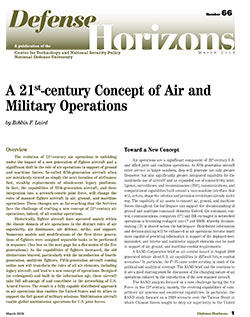DOWNLOAD PDF
 Overview
Overview
The evolution of 21st-century air operations is unfolding under the impact of a new generation of fighter aircraft and a significant shift in the role of air operations in support of ground and maritime forces. So-called fifth-generation aircraft often are mistakenly viewed as simply the next iteration of airframes: fast, stealthy replacements of obsolescent legacy platforms. In fact, the capabilities of fifth-generation aircraft, and their integration into a network-centric joint force, will change the roles of manned fighter aircraft in air, ground, and maritime operations. These changes are so far-reaching that the Services face the challenge of crafting a new concept of 21st-century air operations, indeed, of all combat operations.
Historically, fighter aircraft have operated mainly within the classic domain of air operations in the distinct roles of air superiority, air dominance, air defense, strike, and support. Numerous models and modifications of the first three generations of fighters were assigned separable tasks to be performed in sequence. (See box on the next page for a discussion of the five generations.) As the capabilities of fighters increased, the old distinctions blurred, particularly with the introduction of fourth-generation, multirole fighters. Fifth-generation aircraft coming online now will transform the roles of all air elements, including legacy aircraft, and lead to a new concept of operations. Designed (or redesigned) and built in the information age, these aircraft take full advantage of and contribute to the networking of U.S. Armed Forces. The result is a fully capable distributed approach to air operations that enables the United States and its allies to support the full gamut of military missions. Multimission aircraft enable global multimission operations for U.S. joint forces.
READ MORE >>